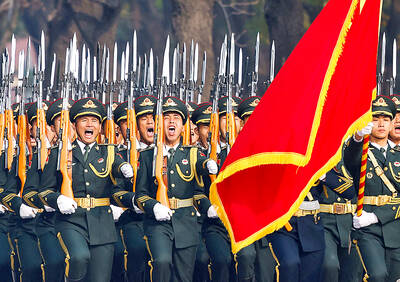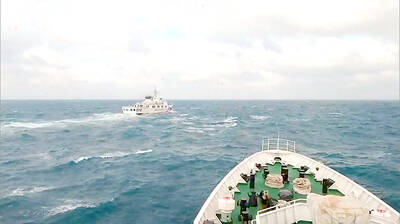The US is to deliver High Mobility Artillery Rocket Systems (HIMARS) to Taiwan a year ahead of schedule, in 2026, with the delivery being expedited in response to rising military tensions across the Strait, the Ministry of National Defense said.
Taiwan agreed to buy 29 HIMARS worth NT$32.5 billion (US$1.06 billion), including an initial order of 11 systems and an additional 18 to replace 40 M109A6 self-propelled howitzers, Lee Shih-Chiang (李世強), director of the ministry’s Department of Strategic Planning, told lawmakers on Thursday.
The first 11 systems are on sechedule, to be delivered next year or in 2025, while the additional 18 are to arrive in 2026, ahead of the planned 2027 or 2028 delivery, Lee said.

Photo: AP
The army’s procurement of rocket artillery systems and ammunition additionally includes 84 Army Tactical Missile Systems (ATACMs) with a nominal range of 300km and 864 Guided Multiple Launch Rocket Systems (GMLRS), with a nominal effective range of 42km, he said.
Separately, retired admiral Huang Shu-kuang (黃曙光), convener of the Presidential Office’s indigenous submarine task force, said yesterday that the nation is on track to put the first indigenous submarine to sea in September.
He made the remark at a National Taiwan Ocean University event discussing the nation’s shipbuilding programs.
Submarines are crucial for Taiwanese security, as the nation’s geostrategic position on the first island chain is better suited for a defensive posture based on submarine warfare than strength-on-strength surface action, Huang said.
The nation’s security strategy should involve improving the capability of the armed forces and banding with other democratic nations to form a defensive alliance in the Indo-Pacific region, he said.
Taiwan began efforts to obtain submarines under former president Lee Teng-hui’s (李登輝) administration, but the first attempts were unsuccessful due to diplomatic constraints, Huang said.
The indigenous defense submarine program was proposed near the end of former president Ma Ying-jeou’s (馬英九) term and continued by President Tsai Ing-wen (蔡英文), he said.
Precision strike missiles, submarines, undersea vessels, missile-firing boats, and mines and minelayers must be developed to defend the maritime logistical lifelines the nation depends on for gas and strategic resources, Huang said.
The university is at the forefront of the nation’s bid to develop AI-based autonomous uncrewed undersea vessels, and a prototype has successfully completed an one-hour undersea voyage, university president Cheng Ying-yao (鄭英耀) said.

Conflict with Taiwan could leave China with “massive economic disruption, catastrophic military losses, significant social unrest, and devastating sanctions,” a US think tank said in a report released on Monday. The German Marshall Fund released a report titled If China Attacks Taiwan: The Consequences for China of “Minor Conflict” and “Major War” Scenarios. The report details the “massive” economic, military, social and international costs to China in the event of a minor conflict or major war with Taiwan, estimating that the Chinese People’s Liberation Army (PLA) could sustain losses of more than half of its active-duty ground forces, including 100,000 troops. Understanding Chinese

The Ministry of Foreign Affairs (MOFA) yesterday said it is closely monitoring developments in Venezuela, and would continue to cooperate with democratic allies and work together for regional and global security, stability, and prosperity. The remarks came after the US on Saturday launched a series of airstrikes in Venezuela and kidnapped Venezuelan President Nicolas Maduro, who was later flown to New York along with his wife. The pair face US charges related to drug trafficking and alleged cooperation with gangs designated as terrorist organizations. Maduro has denied the allegations. The ministry said that it is closely monitoring the political and economic situation

UNRELENTING: China attempted cyberattacks on Taiwan’s critical infrastructure 2.63 million times per day last year, up from 1.23 million in 2023, the NSB said China’s cyberarmy has long engaged in cyberattacks against Taiwan’s critical infrastructure, employing diverse and evolving tactics, the National Security Bureau (NSB) said yesterday, adding that cyberattacks on critical energy infrastructure last year increased 10-fold compared with the previous year. The NSB yesterday released a report titled Analysis on China’s Cyber Threats to Taiwan’s Critical Infrastructure in 2025, outlining the number of cyberattacks, major tactics and hacker groups. Taiwan’s national intelligence community identified a large number of cybersecurity incidents last year, the bureau said in a statement. China’s cyberarmy last year launched an average of 2.63 million intrusion attempts per day targeting Taiwan’s critical

‘SLICING METHOD’: In the event of a blockade, the China Coast Guard would intercept Taiwanese ships while its navy would seek to deter foreign intervention China’s military drills around Taiwan this week signaled potential strategies to cut the nation off from energy supplies and foreign military assistance, a US think tank report said. The Chinese People’s Liberation Army (PLA) conducted what it called “Justice Mission 2025” exercises from Monday to Tuesday in five maritime zones and airspace around Taiwan, calling them a warning to “Taiwanese independence” forces. In a report released on Wednesday, the Institute for the Study of War said the exercises effectively simulated blocking shipping routes to major port cities, including Kaohsiung, Keelung and Hualien. Taiwan would be highly vulnerable under such a blockade, because it